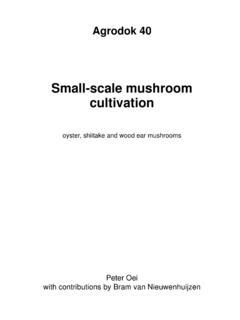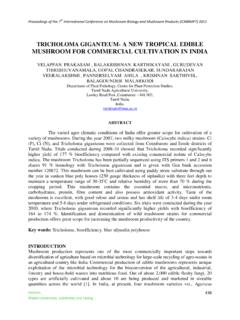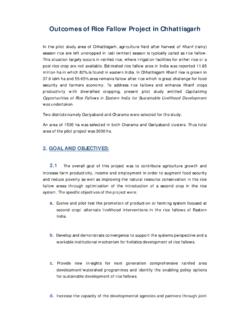Transcription of CHAPTER 2: TECHNOLOGY OF MUSHROOM CULTIVATION
1 CHAPTER 4: TECHNOLOGY OF MUSHROOM . CULTIVATION . Synopsis This CHAPTER deals with the principles and practices of gourmet and medicinal MUSHROOM cultivations. It stresses that successful CULTIVATION involves the interaction of scientific knowledge and practical experience. Annual world production of gourmet and medicinal mushrooms is now estimated in excess of 14 billion US dollars. The operations essential to successful CULTIVATION involve: selection of MUSHROOM spores or strains, maintenance of mycelial cultures, development of spawn or inoculum, preparation of growing medium, inoculation and colonization, and crop management for optimum production.
2 However, for greater pharmaceutical acceptance it is increasingly being recognized that product formation by way of fermenter-grown mycelial biomass will be the preferred option in many cases. Introduction MUSHROOM science is the discipline that is concerned with the principles and practices of MUSHROOM CULTIVATION . As is true in any branch of science, it is essential to establish the facts upon which principles can be derived for future developments of the discipline. Consistent production of successful MUSHROOM crops will be built upon scientific knowledge and practical experience (Chang and Miles, 1989).
3 Rhere are at least 12,000 species of fungi that can be considered as mushrooms with at least 2,000 species showing various degrees of edibility (Chang, 1999a). Furthermore, over 200 species of MUSHROOM have been collected from the wild and utilized for various traditional medical purposes mostly in the Far East. To date, about 35 MUSHROOM species have been cultivated commercially and of these, about 20 are cultivated on an industrial scale (Table 1). The majority of these cultivate species are both edible and possess medicinal properties. However, two of the major medicinal mushrooms , viz.
4 Ganoderma lucidum and Trametes (Coriolus). 64. spp. are distinctly inedible. Overall, the world production of cultivated edible and/or medicinal mushrooms was recorded as 4, x 103 tons in 1994 increasing to 6, x 103 in 1997 with an estimated value in excess of 14 billion US dollars (Chang, 1999b). MUSHROOM CULTIVATION is a worldwide practice (Table 2). In percentage terms, output yield of the leading 10 species cultivated made up c 92% of total world production of these six species, viz: Agaricus bisporus ( ); Lentinus edodes ( ), Pleurotus spp. ( ), Auricularia auricula ( ), Flammulina velutipes ( ), and Volvariella volvaceae ( ), made up 87% of the total production.
5 It can be further observed that by late 1994, of these six species only Agaricus and Pleurotus were cultivated worldwide to be joined in 1997 by Lentinus. The other three of the major six species are grown almost exclusively in Asia (Chang, 1999b). World production of mushrooms over the last two decades has shown a phenomenal pattern of growth (Table 1), with a 5 times increase in tonnage. While the white button MUSHROOM (Agaricus bisporus) still retains the highest overall world production, its relative contribution is decreasing due to the dramatic increase in the other species, viz: Lentinus and Pleurotus in particular.
6 In 1981, Agaricus production represented 72% of world production but by 1997 this had dropped to 32%. Overall, world production of mushrooms is increasingly being dominated by species that are both edible and have medicinal properties. 65. Table 1 World Production of Cultivated Edible and Medicinal mushrooms in Different Years (Chang, 1999b). 1981 1986 1990 1994 1997. Fresh Wt Fresh Wt Fresh Wt Fresh Wt Fresh Wt 3 3 3 3 3. X 10 X 10 X 10 X 10 X 10. Species Metric tons % Metric tons % Metric tons % Metric tons % Metric tons %. Agaricus bisporus/ 1, 1, 1, 1, bitorquis Lentinus edodes 1, Pleurotus spp.
7 Auricularia spp. Volvariella volvacea Flammulina velutipes Tremella spp. - - Hypisizygus spp. - - - - Pholiota spp. Grifola frondosa - - - - Others Total 1, 2, 3, 4, 6, Increasing % 66. It is pertinent to note that world production of mushrooms is now dominated by China with over 64% of total production. China has become a major producer and consumer of both edible and medicinal mushrooms . Furthermore, China is also the major producer of the non-edible medicinal mushrooms , Wolfiporia (Poria) cocos (10,000 tons) and Ganoderma lucidum (4,000 tons) (see CHAPTER 3). At least 10 new species of edible or medicinal mushrooms have been brought into CULTIVATION in China in recent years and although as yet on a small scale, the potential, especially for mushrooms of medicinal value, is quite significant.
8 Because of their historical background in the use of wild mushrooms , both as food and in Chinese traditional medicines, it is to be expected that China will continue to develop methods for CULTIVATION of an increasing number of, as yet, uncultivatable mushrooms for medicinal exploitation. The traditional acceptance of mushrooms in herbal medicine and in expanding pharmaceutical industries, will ensure that China will continue to be a major exploiter of medicinal MUSHROOM TECHNOLOGY (Yamanake, 1997). China is also investing heavily in fermenter TECHNOLOGY for growing MUSHROOM mycelium of medicinal species.
9 Historically, mushrooms were gathered from the wild for consumption and for medicinal use. China has been the source of many early cultivations of mushrooms , Auricularia auricula (600 AD), Flammulina velutipes (800 AD), Lentinus edodes (1000AD) and Tremella fuciformis (1800). Agaricus bisporus was first cultivated in France in c 1600 while Pleurotus ostreatus was first grown in US in 1900. While MUSHROOM CULTIVATION now spans many centuries, it is only over the last 2-3 decades that there have been major expansions in basic research and practical knowledge leading to the creation of a major worldwide industry (Chang and Miles, 1989).
10 67. Table 2 World population of cultivated edible and medicinal mushrooms in 1997 (Metric tons) (Chang, 1999b). China Japan Rest of Asia North Latin EU Rest of Africa China Total %. America Amreica Europe Agaricus 330000 - 68400 425300 51600 875000 115200 36000 54400 1955000 bisporus Lentinus 1397000 115300 47400 3600 300 500 300 - - 1564400 edodes Pleurotus 760000 13300 88400 1500 200 6200 5800 200 - 875600 spp. Auricularia 48000 - 5300 - - - - - - 485300 spp. Volvariella 12000 - 60800 - - - - - - 180800 volvacea Flammulina 15000 10900 25700 - - - - - - 284700 spp. Tremella spp.






